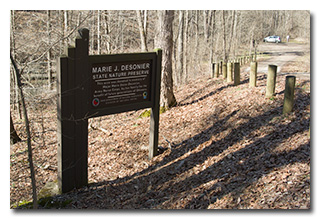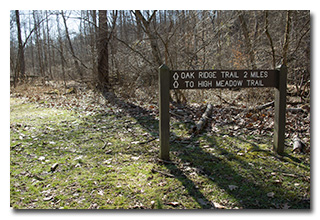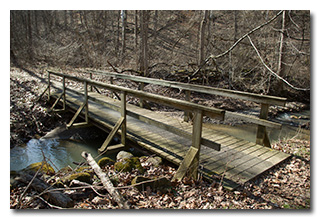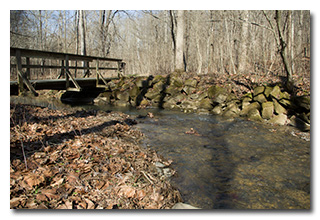
by William Eric McFadden
From the nature preserve's website:
-
This 491-acre preserve encompasses a variety of habitats typical of Appalachian Ohio. The area is diverse in vegetation and ranges from various successional stages to mature forests in the deep ravines and on the steep hillsides. The area is dissected by Jordan Run, a tributary of the Hocking River, and has steep topography, varying from 680 to 900 feet in elevation. Large beech and oak trees are found in the cool moist ravines while the drier uplands are dominated by oak hickory forests, typical of the region.
Due to the diversity of the landscape, a large variety of ferns and wildflowers abound. Some of the more interesting plants include weak aster, green adder's-mouth orchid and Virginia meadow-beauty. Mistletoe, a parasitic plant on trees, has also been reported from this preserve. The most notable landscape feature is a large pond created by beaver, complete with many trees bearing the marks of these industrious animals and a stick-built den. The pond, which stretches for several acres, draws a variety of migratory waterfowl.
The preserve was a gift of Henry I. Stein, who gave the area to the Division of Natural Areas and Preserves in 1974 as a memorial to his sister, Marie J. Desonier.
Pictures
Description
 On Sunday, February 27, 2022, two members of the Southeast Ohio Radio Adventure Team
performed a successful activation of Desonier State Nature Preserve in Ohio as part of the Parks on the
Air (POTA; link) program.
On Sunday, February 27, 2022, two members of the Southeast Ohio Radio Adventure Team
performed a successful activation of Desonier State Nature Preserve in Ohio as part of the Parks on the
Air (POTA; link) program.
Eric McFadden, WD8RIF, and Miles McFadden, KD8KNC, visited Desonier State Nature Preserve on a beautiful but gusty late-February afternoon, arriving at about 1850 UTC. Eric and Miles were accompanied by Vickie McFadden, KC8MAJ, and the two small dogs, Mindy and Theo. Because Ohio forbids pets at all State Nature Preserves, Theo and Mindy were kept on-leash and were not taken beyond the parking area. This was the second POTA CW activation of Desonier State Nature Preserve, the first being Eric's activation on August 19, 2019 (link).
 Eric had hoped to try his new W3EDP Jr. antenna on this
activation, but when no quick deployment options were found, Eric and Miles instead deployed Eric's tried-and-true
28½' wire vertical on a Jackite 31' telescoping fiberglass mast and drive-on mount. Eric set up his KX3
inside the car and was on the air at 1900 UTC.
Eric had hoped to try his new W3EDP Jr. antenna on this
activation, but when no quick deployment options were found, Eric and Miles instead deployed Eric's tried-and-true
28½' wire vertical on a Jackite 31' telescoping fiberglass mast and drive-on mount. Eric set up his KX3
inside the car and was on the air at 1900 UTC.
As he had expected, Eric found he had good cell-signal at this location, and he was able to spot himself to POTA Spots (link) and to use POTA Spots to identify possible park-to-park (P2P) QSO opportunities.
Eric began operations by consulting POTA Spots for P2P QSO opportunities but the pile-ups were too deep for all activations he tried so, rather than spend time trying to break the pile-ups, Eric decided to go to 40m to run a frequency.
 Finding himself a frequency to run on 40m, Eric began calling "CQ POTA" and was pleased to see that POTA Spots
automatically spotted him based on his previously-submitted announcement on POTA Spots and the Reverse Beacon Network (RBN, link).
Eric's first QSO came at 1906 UTC with W4TRA in North Carolina. QSOs came very quickly, with Eric's eighteenth
QSO coming at 1920 UTC with K3MRK in Pennsylvania. This fast run included a P2P QSO with KD8IE who was activating
David Berger National Memorial (K-3513) in northeastern Ohio; QSOs with Eric's good friends K8RAT and K4SWL; and QSOs
with operators located in North Carolina (4), Ohio (2), Virginia, Ontario, Tennessee (4), South Carolina, Indiana,
New Hampshire, New York, Wisconsin, and Pennsylvania.
Finding himself a frequency to run on 40m, Eric began calling "CQ POTA" and was pleased to see that POTA Spots
automatically spotted him based on his previously-submitted announcement on POTA Spots and the Reverse Beacon Network (RBN, link).
Eric's first QSO came at 1906 UTC with W4TRA in North Carolina. QSOs came very quickly, with Eric's eighteenth
QSO coming at 1920 UTC with K3MRK in Pennsylvania. This fast run included a P2P QSO with KD8IE who was activating
David Berger National Memorial (K-3513) in northeastern Ohio; QSOs with Eric's good friends K8RAT and K4SWL; and QSOs
with operators located in North Carolina (4), Ohio (2), Virginia, Ontario, Tennessee (4), South Carolina, Indiana,
New Hampshire, New York, Wisconsin, and Pennsylvania.
 Pausing to check POTA Spots for P2P QSO opportunities, at 1923 UTC Eric made a P2P QSO on 40m with KD3D who was
activating Presque Isle State Park (K-1402) in Pennsylvania and a P2P QSO on 40m with KC9UR who was activating
Pokagon State Park (K-2264) in Indiana.
Pausing to check POTA Spots for P2P QSO opportunities, at 1923 UTC Eric made a P2P QSO on 40m with KD3D who was
activating Presque Isle State Park (K-1402) in Pennsylvania and a P2P QSO on 40m with KC9UR who was activating
Pokagon State Park (K-2264) in Indiana.
Finding himself a frequency on 20m to run, Eric called "CQ POTA" and was gratified to see that POTA Spots automatically updated his spot. Eric's first QSO on 20m came at 1936 UTC with NP3V in Puerto Rico. This was followed at 1939 UTC by a QSO with CU3DI in the Azores. Eric's third and final QSO on 20m came at 1939 UTC with a QSO with KG5U in Texas.
Finally, pausing again to check POTA Spots for P2P QSO opportunities, at 1941 Eric made a P2P QSO on 15m with KI5LKS who was activating Fannin Battleground State Historic Site (K-6555) in Texas.
In all, Eric made twenty-three QSOs, including four P2P QSOs. All of Eric's QSOs were CW and were made with five watts output.
Miles did not operate but helped with set-up and tear-down and looked after the small dogs.
(return)